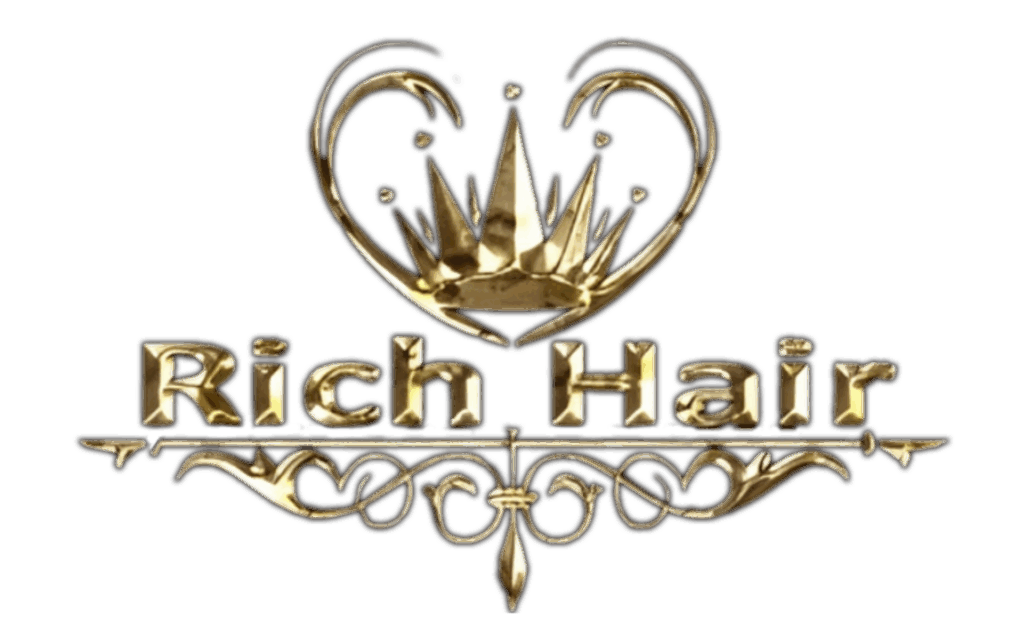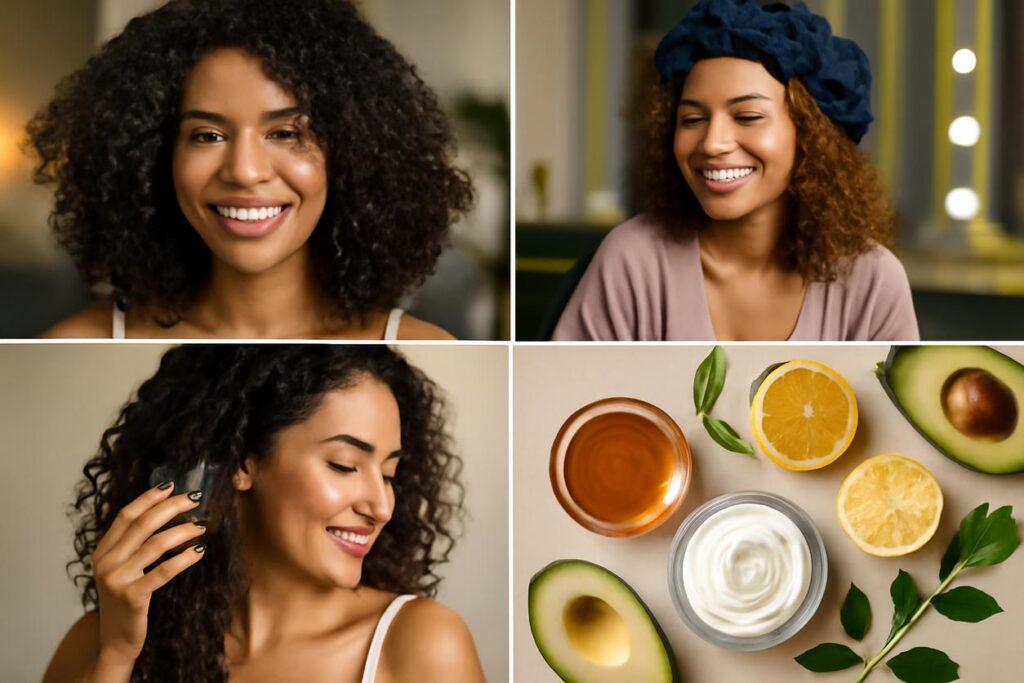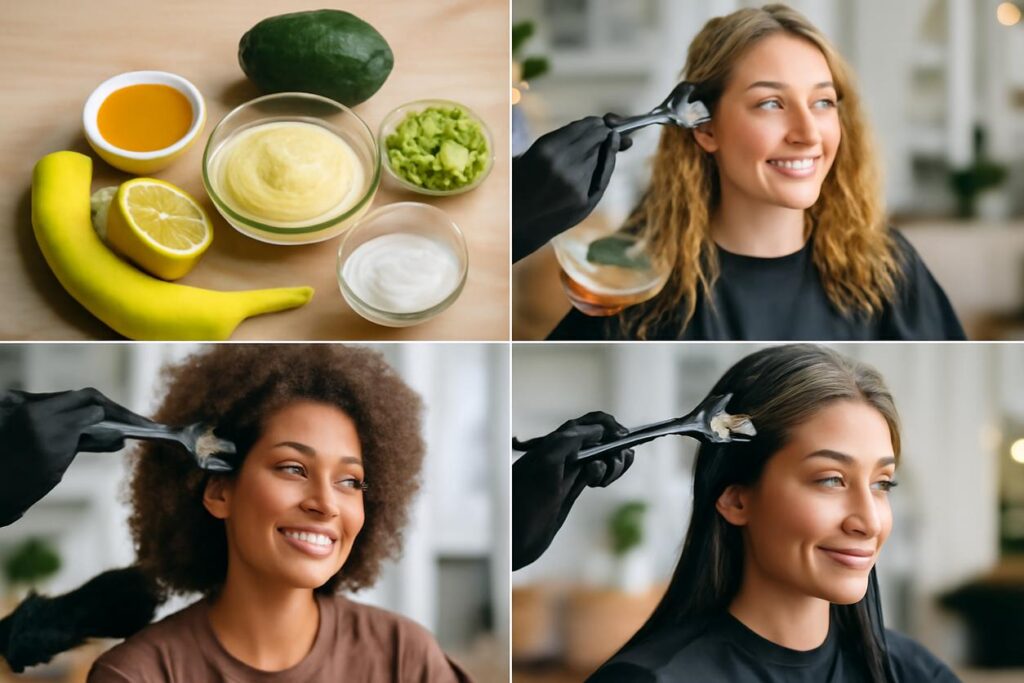Master Your Mane: The Ultimate Guide to Curly Hair Tips for 2025
Welcome to your go-to guide for embracing and enhancing your natural curls. If you have ever felt like your hair has a mind of its own, you are not alone. Curly hair is structurally different from straight hair, and it requires a unique approach to care. Forget the endless battle with frizz and unpredictable volume. The secret to consistently beautiful curls lies not in a single miracle product, but in a holistic routine that nourishes your hair from the inside out. This guide provides actionable curly hair tips that focus on building a simple, sustainable routine, from your morning refresh to your night-time rituals and even the food on your plate.
Rethink Curl Care: It All Starts with Your Routine
The foundation of great curls is consistency. Instead of searching for a quick fix, this guide will help you build a routine that delivers long-term health and definition. By understanding your hair’s specific needs and treating it with gentle, purposeful techniques, you can unlock its full potential. These curly hair tips are designed to be integrated into your life, making beautiful hair an effortless part of your day.
Identify Your Curl Pattern and Porosity
Before you can effectively care for your curls, you need to understand their type and how they behave. This knowledge is the most critical first step in personalizing your hair care regimen.
Understanding Your Curl Pattern
Curl patterns are generally categorized using a number and letter system. While this is not a strict science, it helps you find products and techniques suited for your hair’s shape.
- Type 2 (Wavy): Hair forms an ‘S’ shape. 2A is fine and loose, 2B is slightly more defined, and 2C is a coarse, well-defined ‘S’ wave.
- Type 3 (Curly): Hair forms defined spirals or corkscrews. 3A has large, loose curls, 3B has springy ringlets, and 3C has tight, densely packed corkscrews.
- Type 4 (Coily/Kinky): Hair has very tight coils and zig-zag patterns. 4A features tight ‘S’ coils, 4B has a ‘Z’ pattern with sharp angles, and 4C has the tightest, most densely packed coils with significant shrinkage.
Decoding Hair Porosity
Porosity refers to your hair’s ability to absorb and retain moisture. It is arguably more important than your curl pattern for choosing the right products.
- Low Porosity: The hair cuticle is tightly sealed. Hair resists moisture but holds it well once absorbed. It is often prone to product buildup.
- Medium Porosity: The cuticle is looser, allowing moisture to enter and exit at a balanced rate. This is generally the easiest hair type to manage.
- High Porosity: The cuticle has gaps or holes, causing it to absorb moisture quickly but lose it just as fast. This hair type is often dry, frizzy, and prone to breakage.
A simple at-home test: drop a clean, dry strand of hair into a glass of water. If it floats, you likely have low porosity. If it sinks slowly, you have medium porosity. If it sinks quickly, you have high porosity.
Daily Hydration and a Low-Manipulation Routine
The golden rule of curly hair is hydration. Curls thrive on moisture. A daily low-manipulation routine is essential. This means touching your hair as little as possible to avoid disrupting the curl pattern and causing frizz. In the mornings, you may only need to lightly spritz your hair with water or a water-based leave-in conditioner to reactivate your curls.
Shampooing Smart: How Often and What to Look For
Over-washing is a common enemy of curly hair. Shampoos, especially those with harsh sulfates, can strip the natural oils (sebum) that travel down the hair shaft to keep it moisturized.
How Often to Wash
There is no single answer, but most curly types benefit from washing just 1-3 times per week. Listen to your scalp. If it feels oily or itchy, it is time to wash. If your hair feels dry, try waiting another day or two.
What to Look For in a Shampoo
Opt for a sulfate-free shampoo or a “low-poo” cleanser. Sulfates (like Sodium Lauryl Sulfate) create a rich lather but are harsh detergents that can cause dryness and frizz. A gentler cleanser will clean your scalp without stripping essential moisture.
Conditioning Deep Dive: Co-Wash, Masks and Leave-Ins
Conditioner is a curly person’s best friend. It provides the moisture, slip, and nourishment that curls desperately need. There are several types of conditioning methods to incorporate into your routine.
Co-Washing
Co-washing means washing your hair only with a cleansing conditioner. This is an excellent option for those with very dry or coarse hair, as it cleanses gently without any stripping agents. You can alternate co-washing with a low-poo shampoo to prevent scalp buildup.
Deep Conditioners and Masks
Using a deep conditioner or hair mask once a week is a non-negotiable tip for healthy curls. These intensive treatments are formulated to penetrate the hair shaft, delivering a concentrated dose of moisture and nutrients. Look for ingredients like shea butter, avocado oil, and glycerin.
Leave-In Conditioners
A leave-in conditioner is a lightweight product applied to damp hair after washing. It provides a lasting layer of moisture, helps with detangling, and serves as a great base for your styling products.
Styling Without Heat: Techniques and Product Layering
Minimizing heat styling is one of the most impactful curly hair tips for maintaining health and definition. Air-drying or using a diffuser on low heat and low speed is the best approach. Success comes from a combination of application techniques and product layering.
Key Styling Techniques
- Raking: Use your fingers to rake products through your hair from root to tip for even distribution.
- Prayer Hands: Smooth products down the hair shaft by pressing your palms together with the hair in between. This helps seal the cuticle and reduce frizz.
- Scrunching: Gently cup and squeeze sections of your hair towards the scalp to encourage curl formation.
- Plopping: After applying products, use a cotton T-shirt or microfiber towel to “plop” your hair. This technique absorbs excess water without creating frizz and enhances your natural curl pattern.
Product Layering (LOC or LCO Method)
This method involves layering products to maximize moisture retention.
- LOC: Apply a water-based Leave-in, followed by an Oil to seal, and a Cream to style and define. Best for high-porosity hair.
- LCO: Apply a Leave-in, followed by a Cream, and finish with an Oil to seal everything in. Best for low-porosity hair that can be weighed down by oils.
Night-Time Preservation: Wraps, Silk and Sleep Rituals
How you sleep has a massive impact on how your curls look the next day. A good night-time routine protects your curls from friction, tangles, and moisture loss. This is the secret to extending your wash day and enjoying multi-day hair. You can find more detailed information on night routines for curls to perfect your preservation strategy.
- The Pineapple: Loosely gather your hair into a high ponytail on top of your head. This protects the curls while you sleep.
- Silk or Satin Pillowcase: Cotton absorbs moisture and its rough fibers can cause frizz and breakage. Silk or satin provides a smooth surface for your hair to glide over.
- Bonnets and Scarves: For extra protection, especially for tighter curl patterns, a silk or satin bonnet or scarf will keep your curls contained and hydrated overnight.
Nutrition and Supplements That Support Hair Strength
Healthy hair starts from within. A balanced diet rich in vitamins and minerals is crucial for strong, resilient hair growth. While no food will magically make your hair curly, proper nutrition ensures your hair grows in its healthiest state. According to hair nutrition studies, certain nutrients are vital for hair health.
- Protein: Hair is made of protein (keratin), so ensure you are consuming enough from sources like eggs, fish, and legumes.
- Iron: Iron deficiency can be linked to hair loss. Find it in spinach, red meat, and lentils.
- Biotin: A B-vitamin that contributes to keratin production. Found in nuts, seeds, and sweet potatoes.
- Zinc: This mineral plays a role in hair tissue growth and repair. Oysters, beef, and pumpkin seeds are great sources.
- Omega-3 Fatty Acids: These healthy fats support a healthy scalp. Find them in salmon, avocados, and walnuts.
Simple DIY Masks and When to Use Them
You do not always need expensive products. Your kitchen can provide powerful ingredients for a nourishing hair mask.
Moisture Mask (Use when hair feels dry or brittle)
Mix half a mashed avocado with one tablespoon of honey and one tablespoon of olive oil. Apply to clean, damp hair, leave on for 20-30 minutes, and rinse thoroughly. Avocado provides fatty acids and vitamins, while honey is a natural humectant that draws in moisture.
Protein Mask (Use when hair feels limp or mushy)
Whisk one egg with two tablespoons of plain yogurt. Apply to hair, leave on for 15-20 minutes, and rinse with cool water. The egg provides a protein boost to strengthen the hair shaft. Be careful not to overuse protein treatments, as it can lead to stiffness.
Common Mistakes Curly People Make and How to Fix Them
- Using a regular terry cloth towel: These create frizz. Fix: Switch to a microfiber towel or an old cotton T-shirt.
- Brushing curls when dry: This breaks up curl clumps and causes major frizz. Fix: Only detangle with your fingers or a wide-tooth comb when your hair is wet and saturated with conditioner.
- Applying products to dry hair: Styling products work best on wet or damp hair. Fix: Apply your stylers in the shower on soaking wet hair for best results.
- Ignoring your scalp: A healthy scalp grows healthy hair. Fix: Ensure you are properly cleansing your scalp to remove buildup, even if you co-wash.
Quick Morning Refresh Routines for Defined Curls
Day two or three hair does not have to be a frizzy mess. A quick refresh can bring your curls back to life.
- Dampen: Fill a spray bottle with water and a small amount of your favorite leave-in conditioner. Lightly mist your hair, focusing on frizzy or undefined areas.
- Smooth and Scrunch: Use the “prayer hands” technique to smooth down any frizz. Gently scrunch your hair to re-encourage curl clumping.
- Air Dry: Let your hair air dry completely. This usually takes only 10-15 minutes.
Product Selection Checklist and Ingredient Watchlist
Navigating the product aisle can be overwhelming. Here is a simplified checklist to help you make better choices for your curls in 2025 and beyond.
Ingredients to Look For
- Humectants: Glycerin, honey, agave nectar (draw moisture into the hair).
- Natural Oils and Butters: Shea butter, coconut oil, argan oil, jojoba oil (seal in moisture).
- Fatty Alcohols: Cetyl, stearyl, and cetearyl alcohol (moisturizing, not drying).
- Proteins: Hydrolyzed wheat, soy, or silk protein (strengthen the hair shaft).
Ingredients to Avoid
- Sulfates: Sodium lauryl sulfate, ammonium laureth sulfate (harsh detergents).
- Drying Alcohols: Alcohol denat, ethanol, isopropyl alcohol (can dehydrate hair).
- Certain Silicones: Dimethicone (can cause buildup unless it is water-soluble like cyclomethicone).
- Mineral Oil and Petrolatum: These can create a seal that prevents moisture from getting in.
Maintenance Timeline: Daily, Weekly and Monthly Steps
A structured timeline can help keep your curly hair routine on track. This is a sample schedule you can adapt to your needs.
| Frequency | Task | Description |
|---|---|---|
| Daily | Protect and Refresh | Sleep with a satin bonnet or pillowcase. Refresh curls in the morning with a water spritz. Practice low manipulation. |
| Weekly | Wash and Deep Condition | Cleanse your scalp (with a low-poo or co-wash) 1-3 times a week. Follow with a deep conditioning treatment. |
| Monthly | Clarify | Use a clarifying shampoo to remove any product buildup from your scalp and hair, allowing products to work more effectively. |
| Every 3-4 Months | Trim | Get a trim to remove split ends and maintain the shape of your hair. Consider a stylist trained in cutting curly hair. |
FAQ: Troubleshooting Frizz, Shrinkage and Limp Curls
How do I combat frizz?
Frizz is often a cry for moisture. Ensure your hair is deeply hydrated with regular conditioning masks. Apply styling products to soaking wet hair to lock in moisture and form a “cast,” a crunchy layer that you can gently scrunch out once your hair is 100% dry.
How can I manage shrinkage?
Shrinkage is a sign of healthy, elastic hair, but if you want to show off your length, you can use techniques like banding or twist-outs to gently stretch the hair as it dries. Applying products in a downward motion can also help elongate curls.
What causes my curls to go limp?
Limp curls are often a result of either over-moisturizing (hygral fatigue) or product buildup. Try a clarifying shampoo to reset your hair. If it still feels mushy, it may need a protein treatment to restore its structure. If it feels weighed down, you might be using products that are too heavy for your hair type; try lighter creams or mousses.
Conclusion and Next Steps
Embracing your natural texture is a journey, not a destination. By implementing these curly hair tips for 2025, you are building a foundation for healthy, beautiful hair for years to come. Consistency is your most powerful tool. Pay attention to how your hair responds, adjust your routine accordingly, and be patient with the process. The reward is a head of defined, vibrant, and healthy curls that are uniquely yours.
Ready to dive deeper? Explore our complete curly care hub for more resources, tutorials, and personalized advice to perfect your routine.






